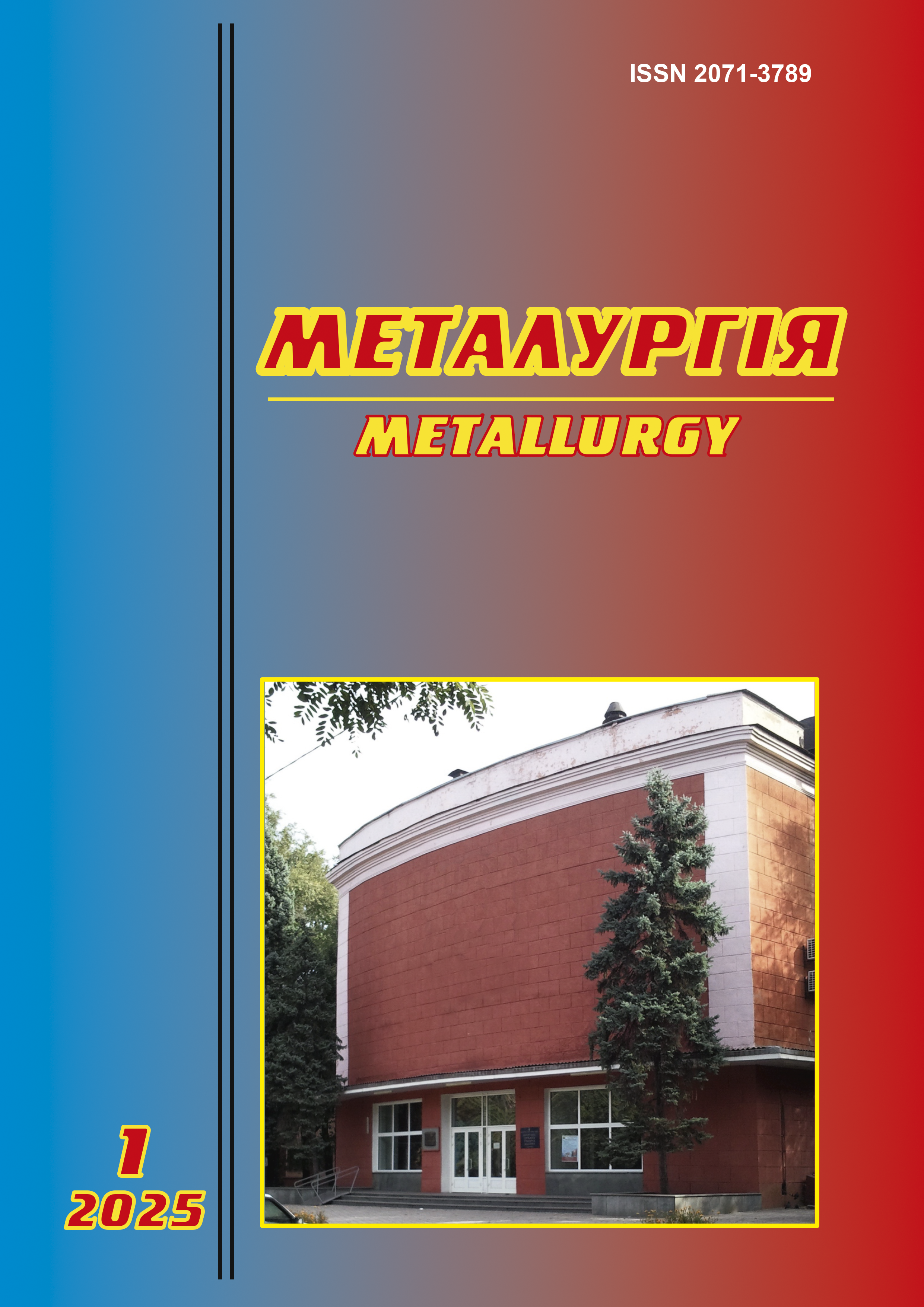ANALYSIS OF PHASE FORMATION PROCESSES IN COMPLEX ALLOYS
Abstract
The study focuses on the phase formation processes in heat-resistant nickel alloys, which are critically important for the aviation and energy industries. These alloys operate under extreme conditions of high temperatures (up to 1373K) and mechanical stresses, particularly in turbine blades of aircraft engines, where exceptional strength and durability are required.In multicomponent systems, the interaction of numerous elements leads to the formation of solid solutions (γ-matrix), intermetallic compounds (γ'-phase), carbides (MC, M23C6), borides (M3B2), and oxide films. Thermodynamic principles, particularly Gibbs free energy minimization, determine the stability of these phases, while kinetic factors, such as atomic diffusion, influence their formation rate.The main phases in nickel alloys include: γ-matrix – a solid solution based on nickel with a face-centered cubic structure, ensuring plasticity; γ'-phase (Ni3(Al, Ta)) – an intermetallic compound occupying up to 70% of the alloy volume in materials like CMSX-4 and serving as the primary strengthening phase; сarbides, which enhance wear resistance; borides, which strengthen grain boundaries; oxide films, which protect against oxidation and reduce its rate by 30–40% at 1373K.Each alloying element plays a specific role: nickel forms the base; aluminum and tantalum contribute to γ'-phase formation; chromium, molybdenum, and tungsten promote carbide formation; boron strengthens grain boundaries; rhenium and ruthenium slow diffusion, increasing creep resistance; rare-earth elements (Ce, Y, La, Nd) form protective oxide films, improving heat resistance.Heat treatment optimizes the γ'-phase particle size (30–40 nm), increasing strength by 10–15%. Adjusting the alloy composition ensures phase balance, preventing harmful topologically close-packed phases, such as the σ-phase. Cooling rate control affects element segregation, and diffusion management, particularly using rhenium, which slows diffusion by 20–30%, enhances durability (Rhenium effect).
References
2. Smallman R. E., Bishop R. J. Modern Physical Metallurgy and Materials Engineering. 6th ed. Oxford : Butterworth-Heinemann, 1999. 448 p.
3. Cahn R. W., Haasen P. Physical Metallurgy. 4th ed. Amsterdam : Elsevier, 1996. 2880 p.
4. Donachie M. J., Donachie S. J. Superalloys: A Technical Guide. 2nd ed. Materials Park, OH : ASM International, 2002. 439 p.
5. Zhang Y., Zhou Y. J., Lin J. P. et al. Solid-Solution Phase Formation Rules for Multi-component Alloys. Advanced Engineering Materials. 2008. Vol. 10, No. 6. Р. 534–538.
6. Reed R. C. The Superalloys: Fundamentals and Applications. Cambridge : Cambridge University Press, 2006. 372 p.
7. Sims C. T., Stoloff N. S., Hagel W. C. Superalloys II: High-Temperature Materials for Aerospace and Industrial Power. New York : Wiley, 1987. 614 p.
8. Lai G. Y. High-Temperature Corrosion and Materials Applications. Materials Park, OH : ASM International, 2007. 461 p.
9. Callister W. D., Rethwisch D. G. Materials Science and Engineering: An Introduction. 9th ed. Hoboken, NJ : Wiley, 2014. 984 p.
10. Pollock T. M., Tin S. Nickel-Based Superalloys for Advanced Turbine Engines: Chemistry, Microstructure, and Properties. Journal of Propulsion and Power. 2006. Vol. 22, No. 2. Р. 361–374.
11. Yeh A. C., Tin S. Effects of Ru and Re Additions on the High-Temperature Stability of Ni-Based Superalloys. Metallurgical and Materials Transactions A. 2006. Vol. 37, No. 9. Р. 2621–2631.
12. Saunders N., Miodownik A. P. CALPHAD (Calculation of Phase Diagrams): A Comprehensive Guide. Oxford : Pergamon, 1998. 479 p.
13. Lukas H. L., Fries S. G., Sundman B. Computational Thermodynamics: The CALPHAD Method. Cambridge : Cambridge University Press, 2007. 324 p.
14. Gessinger G. H. High-Temperature Materials: Nickel-Based Superalloys. Materials Science and Engineering. 1984. Vol. 65, No. 1. Р. 119–132.
15. Wu Q., Song Y. et al. Role of Yttrium in the Oxidation Resistance of Ni-Based Superalloys. Corrosion Science. 2008. Vol. 50, No. 6. Р. 1678–1685.
16. Caron P., Khan T. Evolution of Ni-Based Superalloys for Single Crystal Gas Turbine Blade Applications. Aerospace Science and Technology. 1999. Vol. 3, No. 8. Р. 513–523.
17. Warren P. J., Cerezo A. Rhenium Distribution in Ni-Based Superalloys and Its Effect on Creep Properties. Materials Science and Engineering: A. 1998. Vol. 250, No. 1–2. Р. 88–92.
18. O’Hara K. S., Suzuki W. M. et al. The Effects of Ruthenium Additions on the Microstructure and Properties of Ni-Based Superalloys. Superalloys 2004. Warrendale, PA : TMS, 2004. Р. 911–920.
19. Pint B. A. Oxidation Behavior of Ni-Based Superalloys with Reactive Element Additions. Oxidation of Metals. 1997. Vol. 48, No. 3–4. Р.303–328.
20. Gleeson B. Thermal Barrier Coatings for Aeroengine Applications. Journal of Propulsion and Power. 2006. Vol. 22, No. 2. Р. 375–383.
21. Erickson G. L. The Development and Application of CMSX-10. Superalloys 1996. Warrendale, PA : TMS, 1996. Р. 35–44.
22. MacKay R. A., Nathal M. V. The Role of Tantalum in Ni-Based Superalloys. Superalloys 1992. Warrendale, PA : TMS, 1992. Р.207–216.
23. Liu L. R., Jin T. et al. Effect of Tantalum on the Microstructure and Properties of Ni-Based Superalloys. Materials Science and Engineering: A. 2008. Vol. 479, No. 1–2. Р.351–357.
24. Zhang J., Singer R. F. Effect of Boron on the Microstructure and Properties of Ni-Based Superalloys. Acta Materialia. 2004. Vol. 52, No. 16. Р.4801–4810.
25. Chen W., Chaturvedi M. C. Effect of Boron on the Microstructure and Mechanical Properties of Ni-Based Superalloys. Materials Science and Engineering: A. 1997. Vol. 229, No. 1–2. Р. 163–168.
26. Kattner U. R. Thermodynamic Modeling of Multicomponent Phase Equilibria. JOM. 1997. Vol. 49, No. 12. Р.14–19.
27. Porter D. A., Easterling K. E., Sherif M. Y. Phase Transformations in Metals and Alloys. 3rd ed. Boca Raton, FL : CRC Press, 2009. 520 p.

 ISSN
ISSN 


